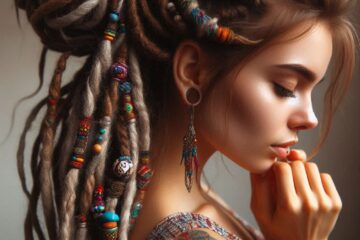A Journey Through Time
Dreadlocks, also known as rastas, are a hairstyle characterized by distinct locks of matted or tangled hair. Their origins can be traced back to ancient civilizations, with evidence suggesting their presence in diverse cultures across the globe. Let’s embark on a journey through time to explore the rich history and enduring legacy of dreadlocks.
Ancient Origins and Cultural Significance:
The exact origins of dreadlocks remain shrouded in mystery, with archaeological evidence suggesting their existence as early as 3000 BC. Depictions of dreadlocks have been found in ancient Egyptian art, Hindu sculptures, and Greek pottery, indicating their widespread presence in various civilizations.
In many ancient cultures, dreadlocks held deep symbolic and cultural significance. They were often associated with spirituality, power, and social status. For instance, in ancient Egypt, dreadlocks were worn by priests and royalty, symbolizing their connection to the divine. Similarly, in some African cultures, dreadlocks were associated with warriors and leaders, representing their strength and resilience.
Dreadlocks in Rastafari Movement:
The Rastafari movement, which emerged in Jamaica in the early 20th century, played a pivotal role in popularizing dreadlocks and imbuing them with profound religious and cultural meaning. Rastafarians believe that dreadlocks are a natural state of hair, symbolizing their covenant with God and their connection to their African heritage.
For Rastafarians, dreadlocks are not merely a hairstyle; they represent a way of life, embodying principles of peace, love, and unity. They are often adorned with beads or shells, each element carrying symbolic meaning. Dreadlocks have become a powerful symbol of Rastafari identity and resistance against oppression.
Evolution and Modern-Day Acceptance:
Over time, dreadlocks have transcended their cultural and religious roots, evolving into a mainstream fashion statement and a symbol of personal expression. Individuals from diverse backgrounds and walks of life have embraced dreadlocks, appreciating their unique aesthetic and the freedom they represent.
Today, dreadlocks are no longer confined to the margins of society; they are seen on celebrities, athletes, and individuals from all walks of life. This widespread acceptance reflects a growing appreciation for cultural diversity and individual expression.
Cultural Appropriation Concerns:
Despite the growing acceptance of dreadlocks, concerns have been raised about cultural appropriation. Cultural appropriation occurs when elements of a marginalized culture are adopted by members of a dominant culture without proper understanding or respect for their original meaning.
In the case of dreadlocks, it is important to acknowledge their deep-rooted cultural significance, particularly within the Rastafari movement. When appropriating dreadlocks, it is crucial to do so with sensitivity and respect, understanding their history and the cultural context they represent.
Conclusion:
Dreadlocks have traversed the corridors of time, carrying with them a rich tapestry of cultural significance, religious symbolism, and personal expression. From their ancient origins to their modern-day prevalence, dreadlocks continue to evolve, reflecting the ever-changing landscape of identity, culture, and personal style. As we move forward, it is essential to approach dreadlocks with understanding, appreciation, and respect for their diverse cultural and historical contexts.
